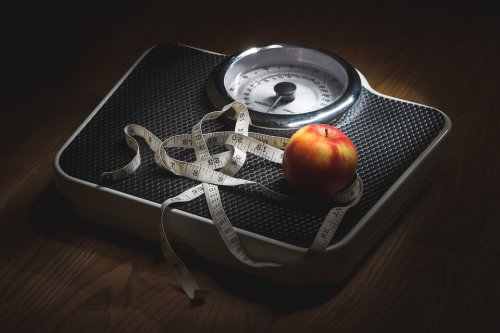Feeding and fasting alignment with the circadian clock speaks to the fact that we have a daily rhythm of sleep and wake; dark, when we’re normally sleeping and fasting, versus light when we’re awake and eating. We have circadian clocks in our brain and throughout our bodies.
I initially wrote about this topic in October 2017; this update is written October 2018. As a topic of ongoing research, it’s critical to provide you with the latest findings, and I’ll continue to do so here.
In October 2017 I attended the Academy of Nutrition and Dietetic’s annual Food and Nutrition Conference and Exhibition (FNCE), where a number of presentations on nutrition, fitness, lifestyle and various types of cancer were featured in the program lineup.
Regardless of the type of cancer addressed in each presentation, there was a general reference to and overall interest in breast cancer. One particularly popular session? “The Evidence: Intermittent Fasting Effects on Cardiometabolic Disease and Cancer.” Given the breast cancer community’s growing interest about this dietary/lifestyle concept, I wanted to learn more about prolonged fasting and its connection to the most common cancer in women worldwide.*
The session was presented by Dr. Dorothy Sears, associate professor in the departments of Medicine and Family Medicine and Public Health at UC San Diego, and Mahshid Shelehchi, MS, RDN a research dietitian at University of Southern California, School of Gerontology, and clinical Research Coordinator at USC+LAC and Norris Cancer Center.
Dr. Sears has been conducting obesity and obesity-related research (which involves extensive work on breast cancer) since 1995, and Mahshid is currently working on two clinical trials on the effect of fasting and low calorie diet on breast and prostate cancer patients.
In this post I focus exclusively on the research presented by Dr. Sears; not to slight Ms. Shelehchi, but to keep the post manageable in length. I’ll certainly address Mahshid’s work in future!

Background From The Trenches
During my years in private practice, I saw many clients who struggled with nighttime eating. Not a little snack before bed, rather, snacking after dinner until bed, and sometimes beyond.
Often, they struggled with nighttime BINGE EATING, or a true binge eating disorder (BED).
Nighttime eating typically happens for one or more of the following reasons:
- Boredom
- Habit
- Stress
- Anxiety
- Dieting backlash (from restricting/deprivation)
- Reward (for getting through the day, going to the gym, getting the kids to bed, etc.)
Nighttime eating can be modified/overcome through behavior change, but it’s not easy.
It takes intention, mindfulness, and lots of practice.
What the nighttime eating I just described ISN’T, is “night eating syndrome” (NES). NES is characterized by a lack of appetite in the morning, overeating at night, and waking to eat throughout the night – sometimes even without remembering. A number of years ago I wrote this article on the topic.
Regardless of whether your after dinner snack habits fit the eat, eat, eat profile or the NES category, you could be putting yourself at higher risk for a first-time breast cancer diagnosis. If you have been diagnosed, night time eating could put you at a higher risk for recurrence.
In my experience, those same clients struggling with either nighttime eating or NES tend also to be overweight or obese. In the event you were unaware, overweight and obesity are strongly linked to breast cancer.
According to statistics from one particular study, the U.S. has the highest fractions attributable to overweight/obesity for postmenopausal breast cancer. It just makes sense to learn more about the connection, what to do about it, and implement strategies for change. (**)
Given that 38% of U.S. women of ALL ages are obese, there’s a strong probability that many newly diagnosed breast cancer patients start treatment at greater potential risk for sub-optimal outcomes following surgery, radiation and chemotherapy, and for experiencing sub-optimal recovery. (***)
So let’s explore this exciting topic, starting with Dr. Sears’ presentation learning objectives:
- Describe the prevalence of obesity and associations with insulin resistance, cardio-metabolic disease, and cancer risk.
- Discuss the variety of intermittent fasting regimens and clinical studies and the evidence supporting health benefits.
- Discuss mechanistic factors linking food intake timing and fasting with health.
- Discuss research supporting use of fasting regimens aligned with circadian rhythm.
Obesity, Insulin Resistance, and Cancer Risk

How does obesity increase breast cancer risk? With increasing obesity, insulin resistance also increases. How to know if you’re insulin resistant? Get tested (blood test.) The results of that test are called a “biomarker”. Positive results (meaning you ARE insulin resistant) indicated by that biomarker are linked to increased cancer risk.
Studies show a very strong and significant relationship between insulin resistance and individuals with a BMI (body mass index) ≥30 (BMI 30 = obese). Research also highlights a link between insulin resistance and increased risk for Type 2 diabetes, fatty liver, cardiovascular disease, and cancer.
What You Need To Know About Insulin Resistance
Insulin is a hormone that drives the storage of fuel (calories) and nutrients.
Insulin is responsible for storing glucose (storage form of carbohydrate), and it’s also important for storing lipids (fats), and regulating the metabolism of amino acids and protein. Insulin works in the liver, adipose (fat) tissue, and muscle.
When someone is insulin resistant, they also have poor glucose control, meaning glucose in the blood is not readily taken up into cells and tissues. The results of this are high levels of blood sugar for extended periods of time, especially following a meal.
Here’s another way to think about it.
It’s like insulin is talking to the body’s cells, telling them to “get that glucose out of the blood and into the cells for storage!” But because the insulin working with the target tissue – let’s say skeletal muscle cells – can’t do its job as well, it’s like the muscle cells aren’t listening, so glucose stays in the blood versus being cleared out and safely stored.
So the insulin? It “talks” louder, meaning the body secretes (releases) insulin at greater and greater levels, trying to get those cells to “listen” and take up that glucose.
This phenomenon results in extended elevated blood glucose – also known as hyperglycemia – while insulin is trying to get the job done. Certain proteins, among them hemoglobin, have lengthy exposure to high glucose levels during this extended period of hyperglycemia.
When this happens, the hemoglobin protein becomes glycated. A clinical marker of hyperglycemia is glycated hemoglobin, which results in high-end-range levels of hemoglobin A1C (HbA1c), an indicator of a complication of high blood sugar. Another indicator of hyperinsulinemia (high insulin levels) is high fasting insulin, another very good biomarker for obesity-related disease risk.
There’s an increased prevalence of insulin resistance worldwide.
In the U.S., one-third of the non-diabetic population (~ 80 million people) has insulin resistance; this population is also referred to as pre-diabetic.
Insulin resistance is a big cancer risk factor, due to the “hyper-activity” of tumors. All cells in the body take up glucose, but when cancer cells experience extended exposure to high levels of blood sugar (glucose), they have more opportunity to guzzle it up – what you may have seen referred to as “feeding cancer cells.”
You can see from this explanation that it’s not necessarily the SUGAR in one’s diet that feeds cancer cells, rather, it’s the high levels of BLOOD SUGAR doing the feeding. This underscores the importance of normal blood sugar levels and regulation.
While genetics are a strong contributing risk factor for insulin resistance, changing your environment by reducing overweight/obesity and improving diet and lifestyle behaviors do make a difference.
Insulin resistance is also associated with increased chronic, systemic inflammation. Inflammation is detected through a CRP blood test revealing high levels of C-reactive protein, an indicator of chronic inflammation in the tissues associated with increased risk factors in the blood.
How To Repair Insulin Resistance?

If insulin resistance drives so many serious diseases, is there anything we can do about it?
YES!
Diet modification and increased levels of physical activity.
Studies show that a 5-7% weight loss and walking 30 minutes almost every day are effective interventions. These are simple for clinicians to suggest, not so simple for people to put into practice, and perhaps more importantly, maintain.
Another intervention gaining attention? Feeding behaviors, which have been shown to modify these risks for diseases associated with insulin resistance and inflammation.
What are Feeding Behaviors?
There are several you may have heard about:
- Fasting, or the voluntary abstinence from food and drink, has been practiced from earliest antiquity by people all over the world. Renewed interest in fasting regimens has led to a number of popular press publications and diets.
- Meal Timing and Frequency has been embraced by the American Heart Association in their scientific statement suggesting attention to timing and frequency of eating leads to reduction of cardio-metabolic risk.
- Intermittent Fasting is associated with improvements in weight and markers of disease risk, yet while the evidence in mice is very strong, and very suggestive in humans, we need more work.
Dr. Sears’ review of the scientific literature has identified 18 small clinical trials on intermittent fasting. Per Dr. Sears, “In my opinion, most intermittent fasting regimens are not real-world feasible. One shortcoming is that they’re not aligned with circadian rhythm. If you fast during the day, you’ll hear people talking about food and you’ll see food commercials or hear them on the radio. When we think about food or smell food, we secrete insulin and digestive enzymes as our bodies prepare for food, making it challenging to fast during the day.” (1)
Different Types of Intermittent Fasting Regimens
All of the examples below are types of “intermittent fasting”, and it’s important to know which regimen someone is following or referring to in order to understand the nuances:
- Complete Alternate Day Fasting – Alternate “fasting” days, where you eat nothing and drink only water, with “eating” days, where you eat anything you want.
- Modified Fasting Regimen – Alternate eating whatever you want with some type of severe calorie restriction. On scheduled fasting days, eat only a small amount of food, ~20-25% of calorie needs. An example is the 5:2 diet, which involves severe energy (calorie) restriction for 2 non-consecutive days per week, and eating without any restriction the other 5 days of the week.
- Time-Restricted Feeding – Eat whatever you want, but only in particular hours of day or night.
- Religious Fasting – Ramadan; sunrise to sundown, during only one time of year. Members of The Church of Latter-Day Saints eat their big meal at 2:00 p.m., and nothing after, per Dr. Sears.
What’s The Evidence in Humans?

- 3 Trials of Alternate Day Fasting
- Samples: 8-30 non-obese adults
- Weight Loss: reduction in body weight of 1-2.5%
- Insulin: some studies show significant changes in fasting insulin, decreases of 52-81%
- 10 Trials of Modified Alternate Day Fasting
- Samples: 10-100 overweight/obese adults
- Weight Loss: reduction of 3-10% body weight
- Insulin: some studies show decreases of 13-37%
- Triglycerides: some studies show decreases of ~20%
- Several Studies of Religious Fasting
- Samples: 4-5 studies of Ramadan
- Temporarily improved lipid panel and glucose regulation
- Within a few months after Ramadan is over, improvements go away.
Because these fasting regimens involve many hours of wake-time, fasting can be problematic for hunger and mood changes.
What About Weight Loss?
A recent 3-Arm randomized clinical trial looked at modified alternate day fasting (ADF) versus calorie restriction (CR), and found that ADF was not superior to CR for weight loss or maintenance, cardio-protection, or adherence. The problem in this trial was poor compliance and high drop-out rate in the ADF group vs. control group (38% vs. 26%). (2)
Time-Restricted Feeding
Time-restricted human feeding studies are small, but show strong potential due to the way this fasting regimen nicely aligns with the circadian cycle.
Feeding and fasting alignment with the circadian clock speaks to the fact that we have a daily rhythm of sleep and wake; dark, when we’re normally sleeping and fasting, versus light when we’re awake and eating. We have circadian clocks in our brain, and we also have circadian clocks throughout our bodies.
The clock in our brain is entrained (meaning to modify the phase or period of) by the sun and indoor light, so when we’re awake and exposed to light, things begin to happen in our bodies, such as physiologic, metabolic, and behavioral programs that are on a 24-hour cycle.
When we introduce food during the day, that is in sync with metabolic and physiological pathways that occur during the day. When we introduce food at night, that is in conflict with metabolic and physiologic pathways activated during the night.
In fact, food can begin to CHANGE the clocks in our metabolic tissues (very powerfully so in the liver), so that the liver is no longer in sync with what’s happening in other parts of the body. Given the strong detoxifying (and other) function of the liver, you can easily see how this could become problematic.
In other words, consuming food outside of the circadian rhythm has negative effects.
Certain hormones, for example, melatonin and growth hormone, are activated at night. Melatonin blocks, and growth hormone interferes with the action of insulin, causing glucose to stay elevated in the blood longer (back to that problem of cells exposed to an extended period of high blood sugar discussed above).
When you eat at night, you actually experience a double whammy; insulin resistance increases throughout the day and into the night i.e., you’re more insulin resistant in the afternoon or evening then you are in the morning.
Over time, the presence of nutrient metabolites in our circulation during “off” times of the circadian cycle will change or blunt gene expression of metabolic pathways that regulate fuel (energy) storage and cell growth. (3)
Eating, Circadian Rhythm, and Its Association With Disease

There is scientific literature that strongly suggests a link between increased risk of disease, including breast cancer, and night shift workers and flight attendants.
There are a number of studies indicating people lose less weight when they eat at night, and while findings need to be confirmed by larger independent studies, suggestion that nighttime eating is associated with increased breast cancer risk.
All of this is indicative of the idea that eating outside of the circadian rhythm is negatively associated with disease risk. (4)
Conversely, eating IN ALIGNMENT with our circadian rhythm is associated with a decreased risk of disease. (5)
Time-Restricted Feeding in Mice
Dr. Sears shared outcomes from several time restricted feeding mouse model studies, one of which is her own study of a female mice model of breast cancer, summarized below:
Time restricted feeding (TRF) study. Control group = mice had 24 hour access to high fat chow (feed.) TRF group = mice had 8 hours access to high fat chow during the night (mice are nocturnal, they eat at night). The prevention or intervention in this study = TRF protects from obesity and associated metabolic disturbances associated with a high fat diet, despite eating the same daily calorie intake. (6, 7, 8)
In other words, even though both the control and the TRF group had access to the same HIGH FAT mouse food that provided the same amount of calories, consuming that food (and calories) within a restricted overnight 8-hour period (in rhythm) resulted in better outcomes than free-eating, 24-hour consumption.
Dr. Sears is co-investigator for a new research project grant to study TRF in a post-menopausal breast cancer mouse model. Preliminary findings indicate that TRF completely blunts the growth of breast tumors in mice that is facilitated by their obesity; tumors grow, but only as fast as in the lean mice. If the mice are obese, tumor growth is enhanced; if they time restrict feed obese mice, tumors grow at the rate observed in lean mice. As of October 2018 this is unpublished data, yet the research was presented at the Experimental Biology meeting in April 2018. The authors are preparing to publish later this year. (9)
What’s Human Evidence for Benefit of a Prolonged Nightly Fasting Interval?
Nightly fasting is “the time between dinner and breakfast with no interim caloric intake.”
Nightly fasting is equivalent to time restricted feeding in the mouse model, where food intake is in circadian alignment with the active eating phase. Since most of the fasting hours are during sleep when we don’t expend much energy and aren’t exposed to food commercials, talking about, seeing or smelling food, prolonged nightly fasting is minimally disruptive and has the appeal of being easy to adopt.
There are currently no appropriately-sized intervention studies in humans.
Update: Since the original writing of this article, research has been ongoing. Here’s an excerpt from a 2021 article referencing Dr. Sears’ work (for full article, see reference #14 in SOURCES).
The researchers note that there have been relatively few human studies looking at the benefits of time-restricted eating. However, the initial findings of those studies back up the benefits seen in animal models, including reductions in body weight, body fat, waist circumference, and body mass index.
One very small 5-week intervention study of 8 prediabetic men showed that even in the absence of weight loss, time restricted feeding seemed to have beneficial effects, yet the study design of 18 hours fasting and 6 hours eating may be challenging for broad acceptability. Dr. Sears shared that she’s currently working to get funding (in 2019) for a study of 250 overweight breast cancer survivors. (10)
In the absence of that data, Dr. Sears shared information from existing large scale studies that points to the potential benefit of prolonged fasting with a focus on the breast cancer population. Choosing to highlight a review of nightly fasting in NHANES (The National Health and Nutrition Examination Survey) women from 2009-2010, and fasting results from the WHEL (Women’s Healthy Living Study), Dr. Sears shared results extrapolated using 24-hour food recall data (not considered the most reliable reporting method), yet because they appear to support what researchers are seeing in animal models and some human intervention trials, they are of interest and importance.
NHANES Fasting Outcomes
Using 24-hour food recall data and with a focus on breast cancer risk, data from 2531 women in the NHANES database revealed a median nighttime fasting time of 12 hours. Review for glucose-regulation and inflammation revealed that prolonged fasting was associated with better glycemic control and decreased inflammation. For every 3-hour increase in nighttime fasting duration, a significant 20% reduced odds of elevated HbA1c (glycosylated hemoglobin) was seen. (11)
When looking at C-reactive protein, the clinical indicator of systemic inflammation, nighttime eating was associated with increased CRP, and longer nighttime fasting duration was associated with lower inflammation. (12)
The WHEL (Women’s Healthy Living Study)

A multi-site study with over 3,000 breast cancer survivors was followed longitudinally with multiple time-stamped food recalls (included 30,000 24-hour food recalls) to extract fasting duration time that revealed clinical outcomes for HbA1c, breast cancer mortality, and breast cancer recurrence.
Women who had a nightly fast of less than 13 hours had an increased risk for breast cancer recurrence in this cohort. They also found that for each 2-hour increase in nightly fasting, lower HbA1c and longer nighttime sleep, both of which are associated with better glycemic control. This is the first human study to demonstrate a clinical outcome associated to prolonged nightly fasting. (13)
Eating after 8:00 p.m. was associated with significantly higher C-reactive protein, yet in all of the fasting models, food quality, total amount, and type of calories didn’t seem to matter; it was more about the timing and what occurs during the fast.
How Does Nightly Fasting Drive Improvements?
Dr. Sears shared three ideas of mechanisms that may be seen in the mice model:
- Impact on Gut Microbiota
The gut has its own circadian rhythm and influences that of the host through metabolites (i.e. bile acids and short chain fatty acids). Fasting may drive changes in the microbiota or in the actual CONTENT of the microbiota that reduce risk factors, such as excess adiposity (fat), insulin resistance, and inflammation.
- Behavioral Factors
Lifestyle changes, such as longer hours of sleep leaving less hours available for eating, result in reduced nighttime food consumption.
- Circadian Rhythm Alignment
Food signals entrain peripheral clocks in our metabolic tissues, synchronize with microbiota rhythms, align food intake with metabolic and other hormone rhythms (insulin secretion and action, melatonin, growth hormone).
Wrap Up
- There is accumulating evidence indicating that short nightly fasting duration and nighttime eating are associated with cardio-metabolic disease and cancer risk.
- A daily practice of fasting during inactive “sleep” phases of the circadian clock is associated with improved metabolic and breast cancer outcomes.
- There is suggestive evidence that supports metabolic benefits and safety of intermittent fasting, however, compliance challenges exist for fasting during “active” phase of the day.
- Using evidence-based messaging about health-promoting food intake timing could have a significant public health benefit.
______________________________________________________________________________________________________________________________
Thanks for reading my blog post!
I help post-treatment survivors of hormone-positive breast cancer end food fear, confusion and overwhelm, eat without stress and guilt, and rebuild their health so they can do the things they enjoy with the people they love.
I’m a registered dietitian, personal trainer, nutrition therapist and coach, speaker, and survivor of hormone-positive breast cancer.
Ready for professional support to rebuild your health and gain peace of mind?
Click this link and watch my HEALTH REBUILD video!
Get my FREE Lifestyle Choices Matter! Get Started Guide here
Follow me on Instagram @hormone.breastcancer.dietitian
This information is for educational purposes only and is not intended as medical advice. Please consult your dietitian or doctor for guidance specific to your needs.
______________________________________________________________________________________________________________________________
Sources
(*) “Breast Cancer Statistics”
(**) “How many cancer cases may be due to obesity?”
(***) “Prevalence of Obesity Among Adults and Youth: United States, 2011–2014”
(1) “Metabolic Effects of Intermittent Fasting.”
(3) “Circadian Control of Metabolism and Pathological Consequences of Clock Perturbations.”
(4) “Nighttime eating and breast cancer among Chinese women in Hong Kong.”
(5) “Circadian rhythms, time-restricted feeding, and healthy aging.”
(9) Time-Restricted Feeding Attenuates Breast Cancer Growth in a Mouse Model of Postmenopausal Obesity
(11) “Prolonged Nightly Fasting and Breast Cancer Risk: Findings from NHANES (2009-2010).”
(13) “Prolonged Nightly Fasting and Breast Cancer Prognosis.”

